Attached files
| file | filename |
|---|---|
| 8-K - FORM 8-K - ZIOPHARM ONCOLOGY INC | d73635d8k.htm |
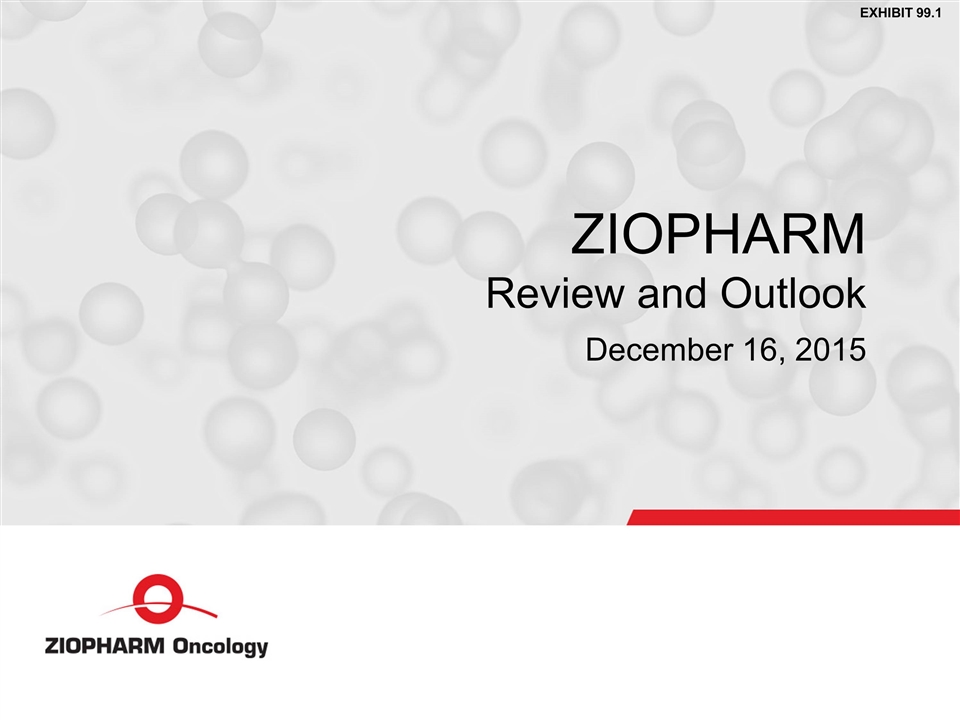
ZIOPHARM Review and Outlook December 16, 2015 EXHIBIT 99.1
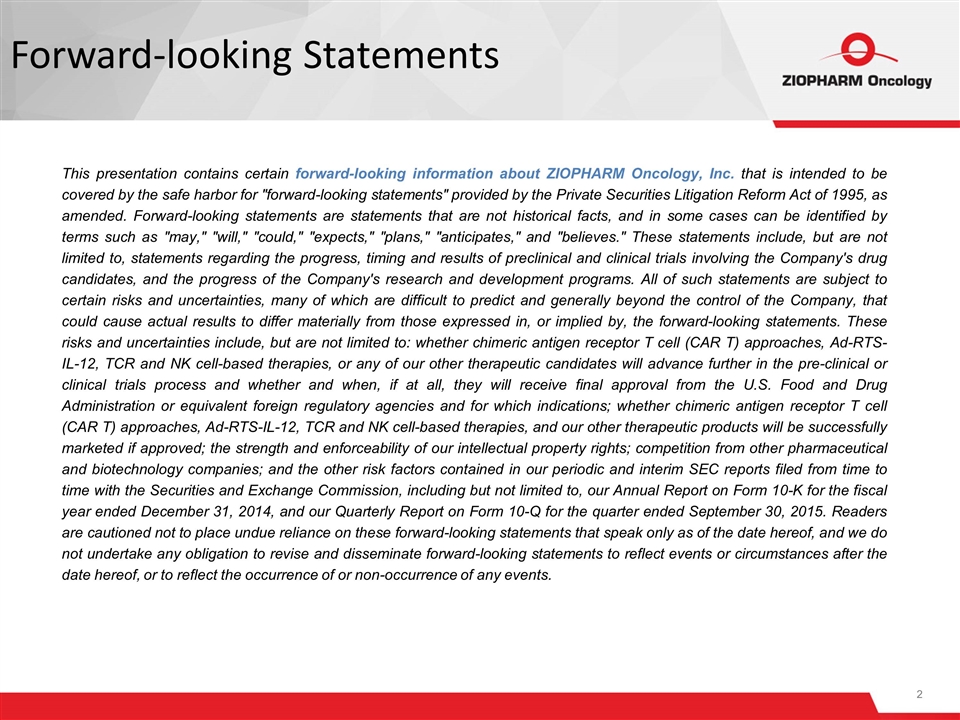
This presentation contains certain forward-looking information about ZIOPHARM Oncology, Inc. that is intended to be covered by the safe harbor for "forward-looking statements" provided by the Private Securities Litigation Reform Act of 1995, as amended. Forward-looking statements are statements that are not historical facts, and in some cases can be identified by terms such as "may," "will," "could," "expects," "plans," "anticipates," and "believes." These statements include, but are not limited to, statements regarding the progress, timing and results of preclinical and clinical trials involving the Company's drug candidates, and the progress of the Company's research and development programs. All of such statements are subject to certain risks and uncertainties, many of which are difficult to predict and generally beyond the control of the Company, that could cause actual results to differ materially from those expressed in, or implied by, the forward-looking statements. These risks and uncertainties include, but are not limited to: whether chimeric antigen receptor T cell (CAR T) approaches, Ad-RTS-IL-12, TCR and NK cell-based therapies, or any of our other therapeutic candidates will advance further in the pre-clinical or clinical trials process and whether and when, if at all, they will receive final approval from the U.S. Food and Drug Administration or equivalent foreign regulatory agencies and for which indications; whether chimeric antigen receptor T cell (CAR T) approaches, Ad-RTS-IL-12, TCR and NK cell-based therapies, and our other therapeutic products will be successfully marketed if approved; the strength and enforceability of our intellectual property rights; competition from other pharmaceutical and biotechnology companies; and the other risk factors contained in our periodic and interim SEC reports filed from time to time with the Securities and Exchange Commission, including but not limited to, our Annual Report on Form 10-K for the fiscal year ended December 31, 2014, and our Quarterly Report on Form 10-Q for the quarter ended September 30, 2015. Readers are cautioned not to place undue reliance on these forward-looking statements that speak only as of the date hereof, and we do not undertake any obligation to revise and disseminate forward-looking statements to reflect events or circumstances after the date hereof, or to reflect the occurrence of or non-occurrence of any events. Forward-looking Statements
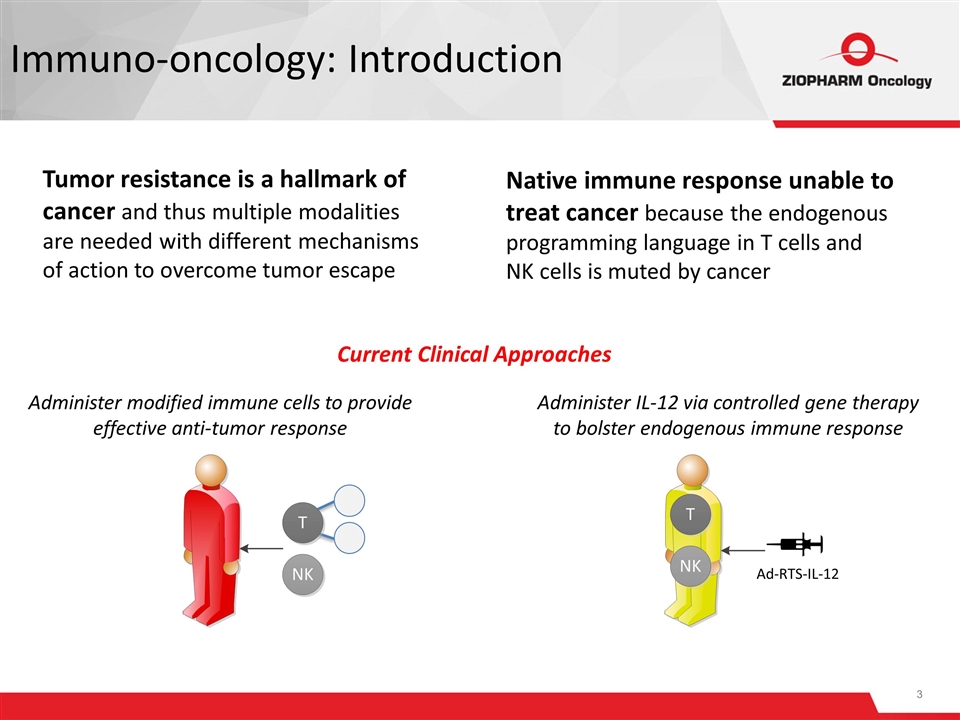
Immuno-oncology: Introduction Tumor resistance is a hallmark of cancer and thus multiple modalities are needed with different mechanisms of action to overcome tumor escape Native immune response unable to treat cancer because the endogenous programming language in T cells and NK cells is muted by cancer Administer modified immune cells to provide effective anti-tumor response Administer IL-12 via controlled gene therapy to bolster endogenous immune response Current Clinical Approaches Ad-RTS-IL-12
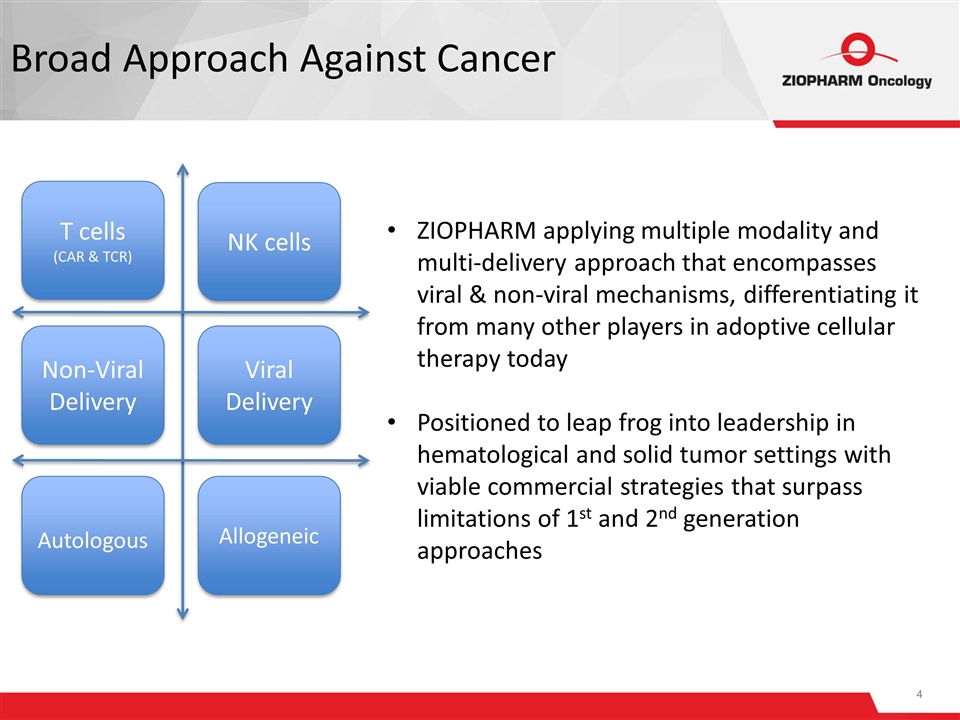
Broad Approach Against Cancer ZIOPHARM applying multiple modality and multi-delivery approach that encompasses viral & non-viral mechanisms, differentiating it from many other players in adoptive cellular therapy today Positioned to leap frog into leadership in hematological and solid tumor settings with viable commercial strategies that surpass limitations of 1st and 2nd generation approaches T cells (CAR & TCR) NK cells Non-Viral Delivery Viral Delivery Autologous Allogeneic
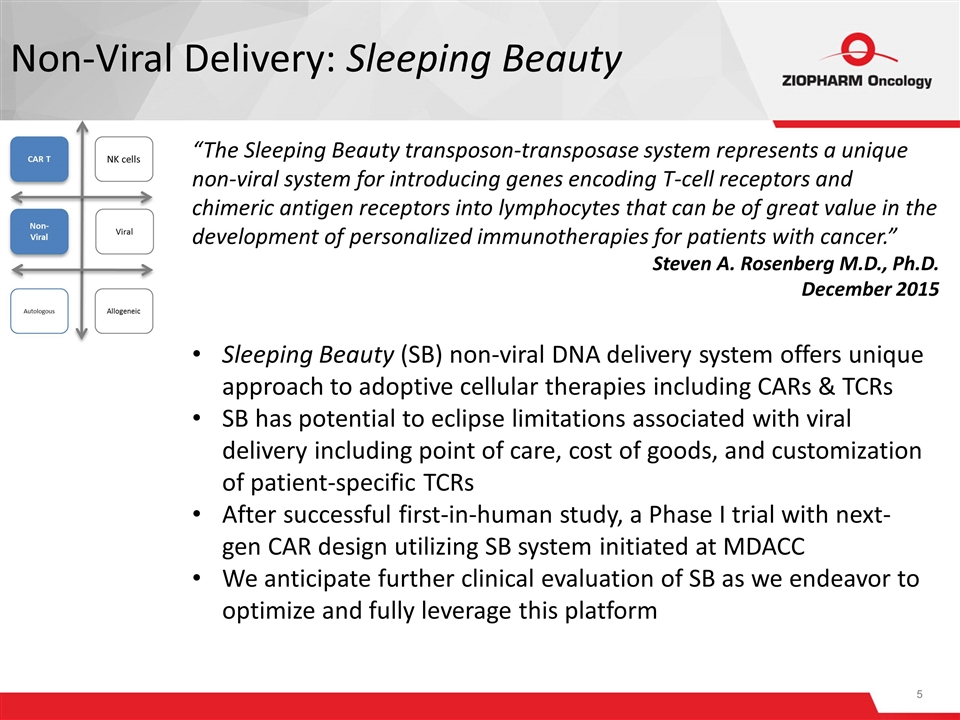
Non-Viral Delivery: Sleeping Beauty Sleeping Beauty (SB) non-viral DNA delivery system offers unique approach to adoptive cellular therapies including CARs & TCRs SB has potential to eclipse limitations associated with viral delivery including point of care, cost of goods, and customization of patient-specific TCRs After successful first-in-human study, a Phase I trial with next-gen CAR design utilizing SB system initiated at MDACC We anticipate further clinical evaluation of SB as we endeavor to optimize and fully leverage this platform CAR T NK cells Non-Viral Viral Autologous Allogeneic “The Sleeping Beauty transposon-transposase system represents a unique non-viral system for introducing genes encoding T-cell receptors and chimeric antigen receptors into lymphocytes that can be of great value in the development of personalized immunotherapies for patients with cancer.” Steven A. Rosenberg M.D., Ph.D. December 2015
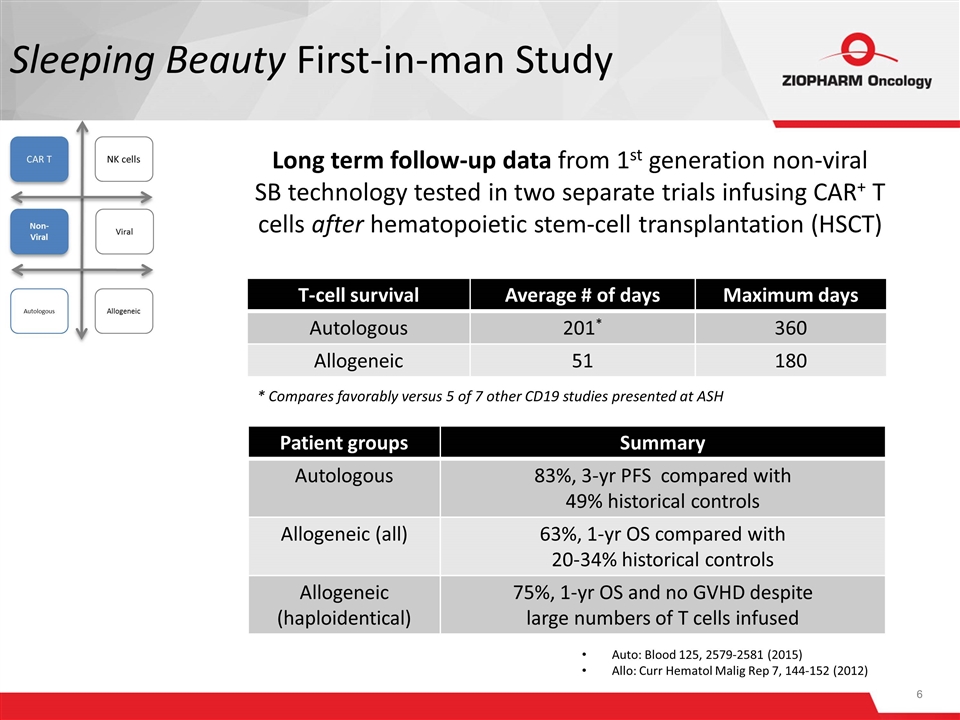
Sleeping Beauty First-in-man Study Long term follow-up data from 1st generation non-viral SB technology tested in two separate trials infusing CAR+ T cells after hematopoietic stem-cell transplantation (HSCT) T-cell survival Average # of days Maximum days Autologous 201* 360 Allogeneic 51 180 Patient groups Summary Autologous 83%, 3-yr PFS compared with 49% historical controls Allogeneic (all) 63%, 1-yr OS compared with 20-34% historical controls Allogeneic (haploidentical) 75%, 1-yr OS and no GVHD despite large numbers of T cells infused Auto: Blood 125, 2579-2581 (2015) Allo: Curr Hematol Malig Rep 7, 144-152 (2012) CAR T NK cells Non-Viral Viral Autologous Allogeneic * Compares favorably versus 5 of 7 other CD19 studies presented at ASH
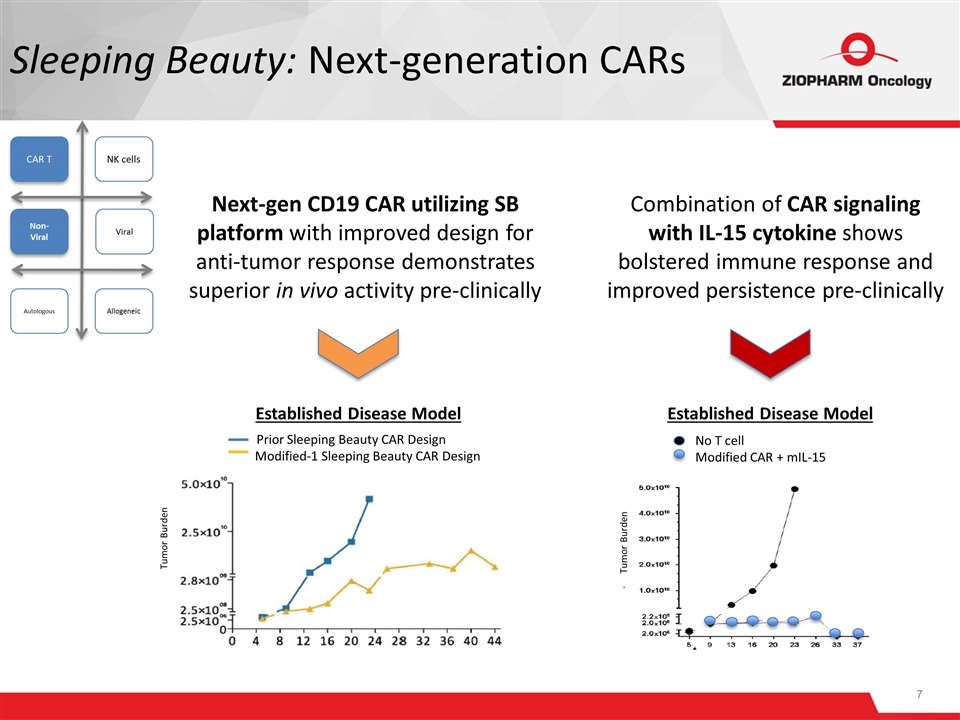
Sleeping Beauty: Next-generation CARs CAR T NK cells Non-Viral Viral Autologous Allogeneic Established Disease Model Prior Sleeping Beauty CAR Design Modified-1 Sleeping Beauty CAR Design Established Disease Model No T cell Modified CAR + mIL-15 Tumor Burden Tumor Burden Combination of CAR signaling with IL-15 cytokine shows bolstered immune response and improved persistence pre-clinically Next-gen CD19 CAR utilizing SB platform with improved design for anti-tumor response demonstrates superior in vivo activity pre-clinically
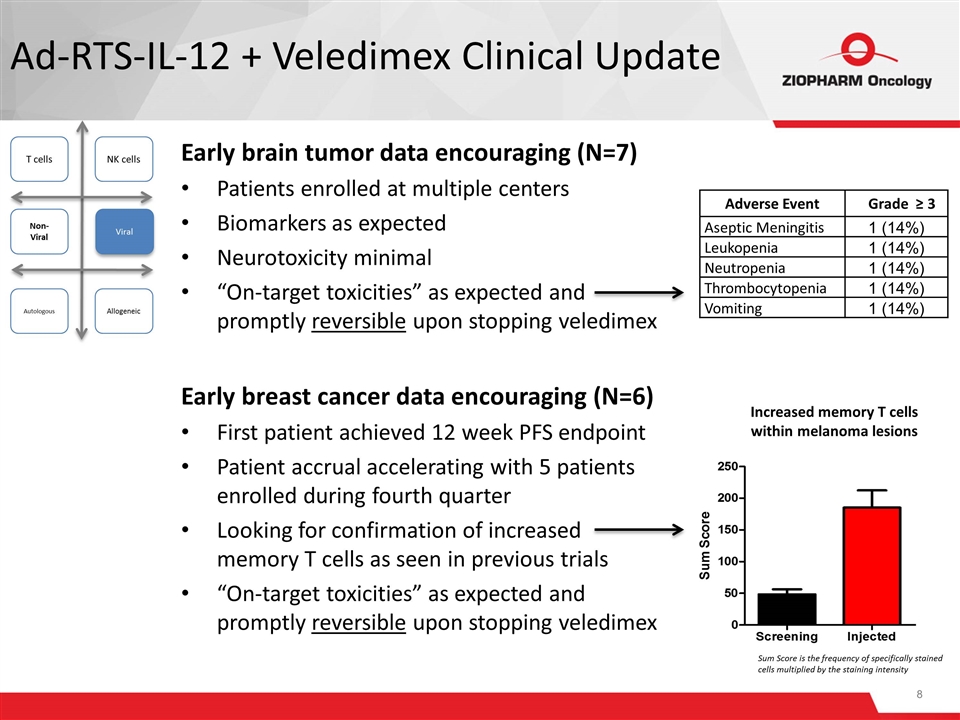
Ad-RTS-IL-12 + Veledimex Clinical Update Early brain tumor data encouraging (N=7) Patients enrolled at multiple centers Biomarkers as expected Neurotoxicity minimal “On-target toxicities” as expected and promptly reversible upon stopping veledimex Early breast cancer data encouraging (N=6) First patient achieved 12 week PFS endpoint Patient accrual accelerating with 5 patients enrolled during fourth quarter Looking for confirmation of increased memory T cells as seen in previous trials “On-target toxicities” as expected and promptly reversible upon stopping veledimex Increased memory T cells within melanoma lesions Adverse Event Grade ≥ 3 Aseptic Meningitis 1 (14%) Leukopenia 1 (14%) Neutropenia 1 (14%) Thrombocytopenia 1 (14%) Vomiting 1 (14%) Sum Score is the frequency of specifically stained cells multiplied by the staining intensity T cells NK cells Non-Viral Viral Autologous Allogeneic

Ad-RTS-IL-12 + Veledimex Control & Safety 52 patients treated to date in 4 different human studies SAEs and Grade 3 related toxicities are rapidly reversible upon discontinuation of veledimex Four cases of Cytokine Release Syndrome (drug related) Reversible with discontinuation of veledimex and supportive care No anti-IL-6 required (Tocilizumab) No vasopressors required No drug related deaths Pattern observed in current GBM and Breast Cancer studies is predictable, consistent and reversible T cells NK cells Non-Viral Viral Autologous Allogeneic
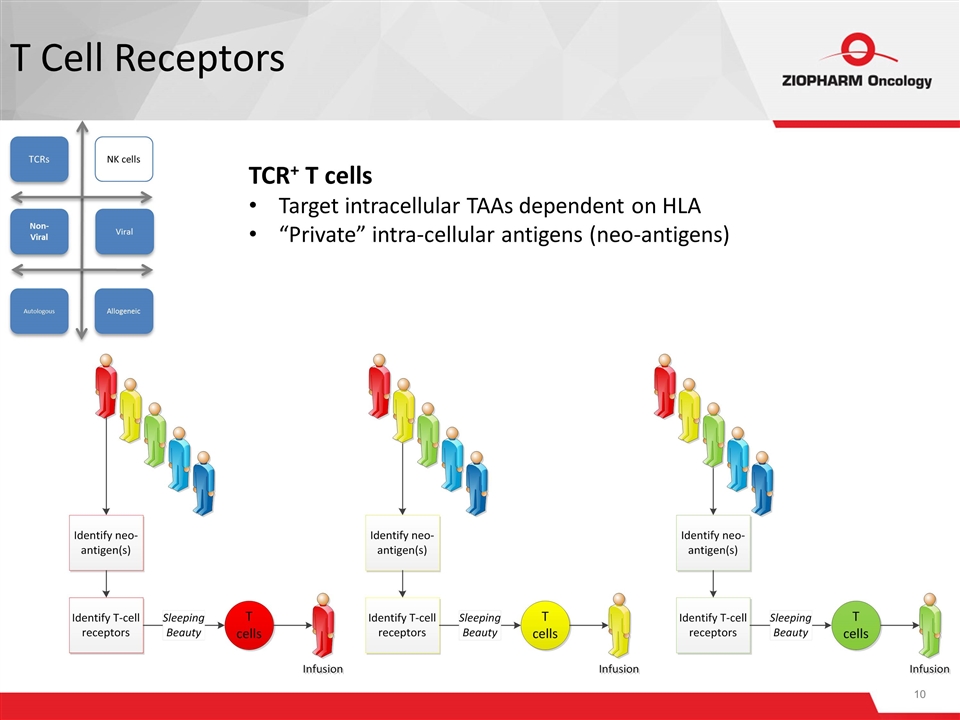
T Cell Receptors TCRs NK cells Non-Viral Viral Autologous Allogeneic TCR+ T cells Target intracellular TAAs dependent on HLA “Private” intra-cellular antigens (neo-antigens)
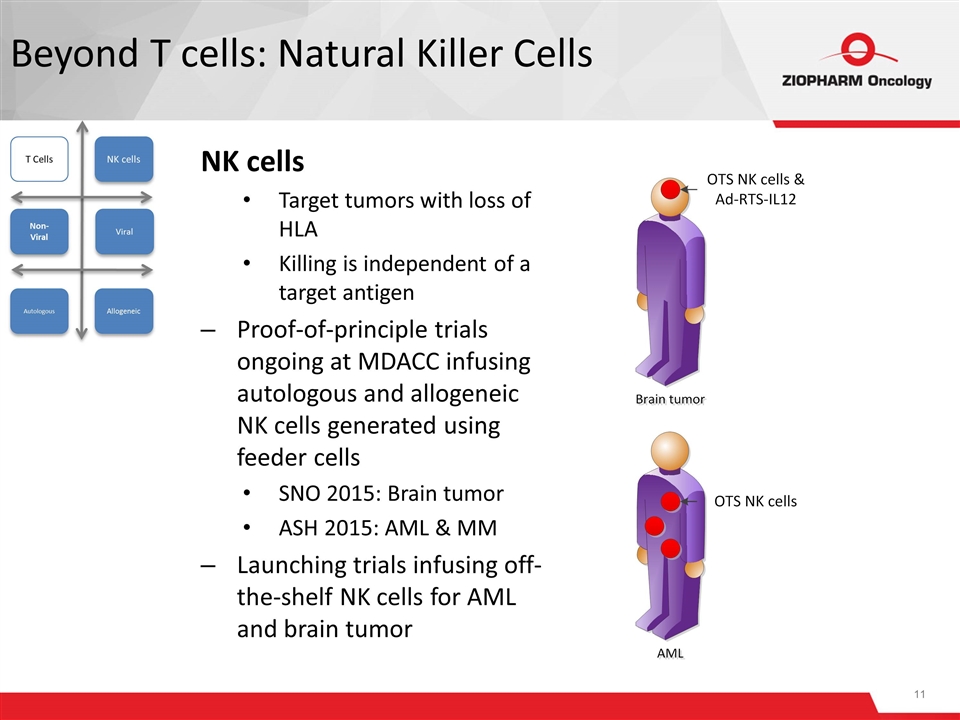
NK cells Target tumors with loss of HLA Killing is independent of a target antigen Proof-of-principle trials ongoing at MDACC infusing autologous and allogeneic NK cells generated using feeder cells SNO 2015: Brain tumor ASH 2015: AML & MM Launching trials infusing off-the-shelf NK cells for AML and brain tumor Beyond T cells: Natural Killer Cells T Cells NK cells Non-Viral Viral Autologous Allogeneic
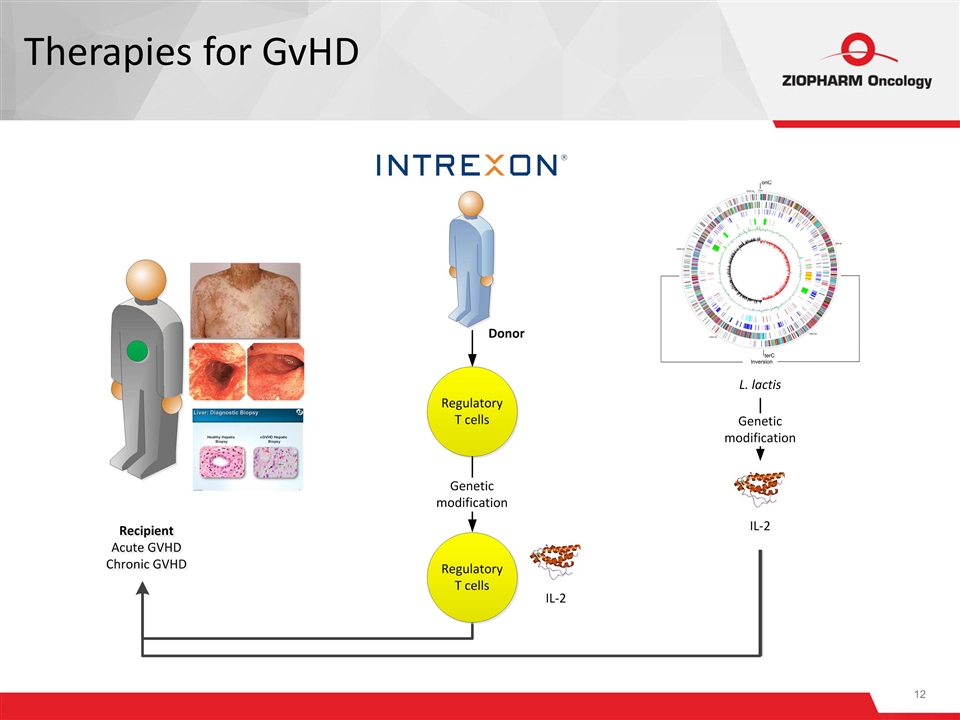
Therapies for GvHD
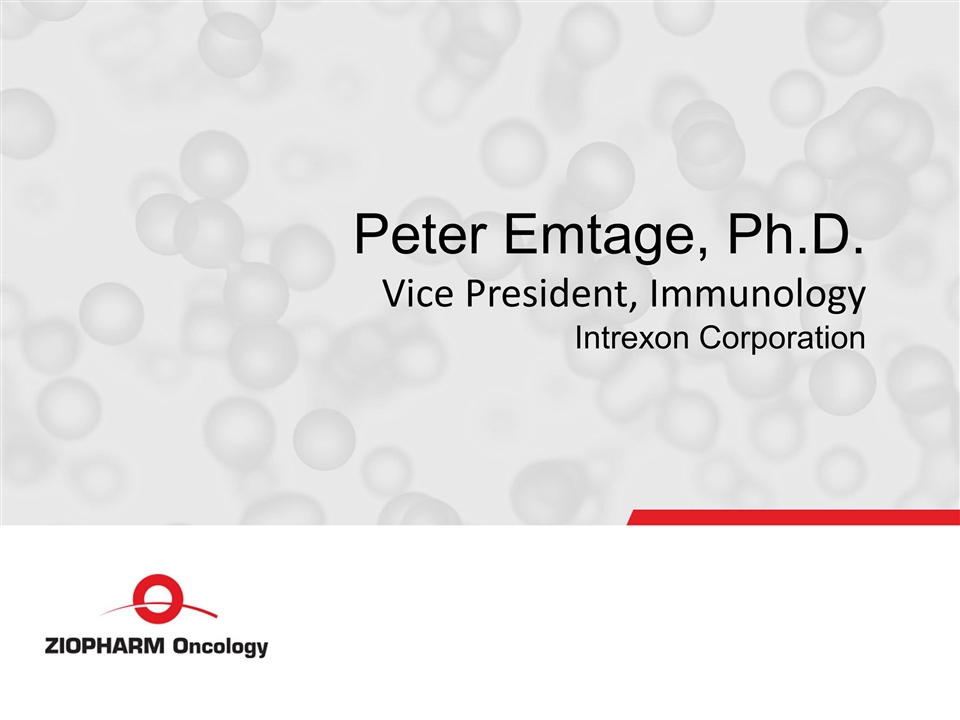
Peter Emtage, Ph.D. Vice President, Immunology Intrexon Corporation
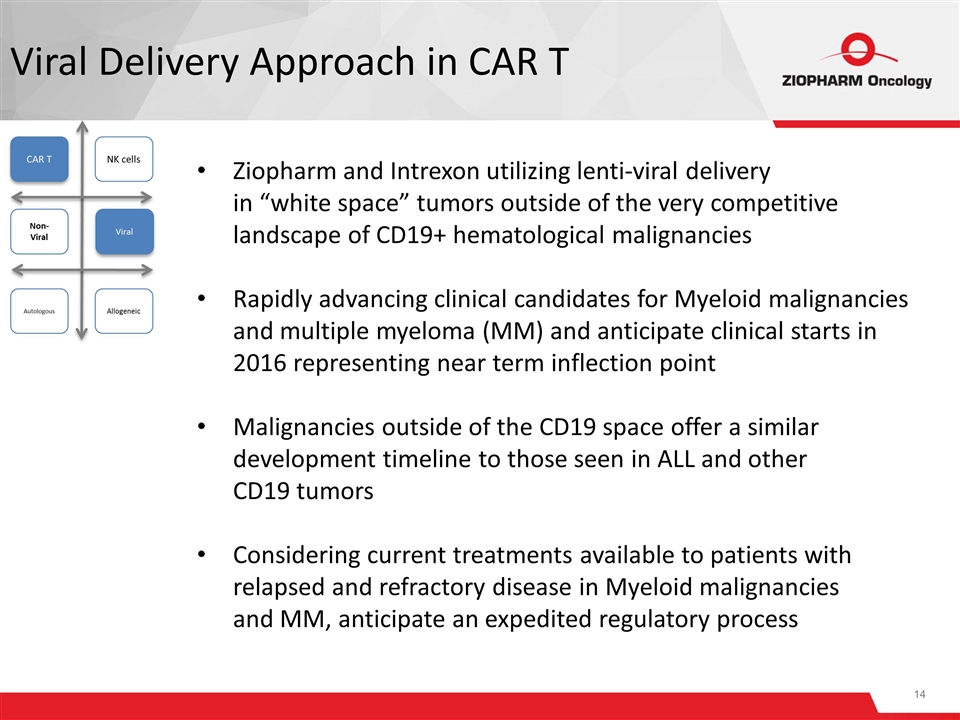
Viral Delivery Approach in CAR T Ziopharm and Intrexon utilizing lenti-viral delivery in “white space” tumors outside of the very competitive landscape of CD19+ hematological malignancies Rapidly advancing clinical candidates for Myeloid malignancies and multiple myeloma (MM) and anticipate clinical starts in 2016 representing near term inflection point Malignancies outside of the CD19 space offer a similar development timeline to those seen in ALL and other CD19 tumors Considering current treatments available to patients with relapsed and refractory disease in Myeloid malignancies and MM, anticipate an expedited regulatory process CAR T NK cells Non-Viral Viral Autologous Allogeneic
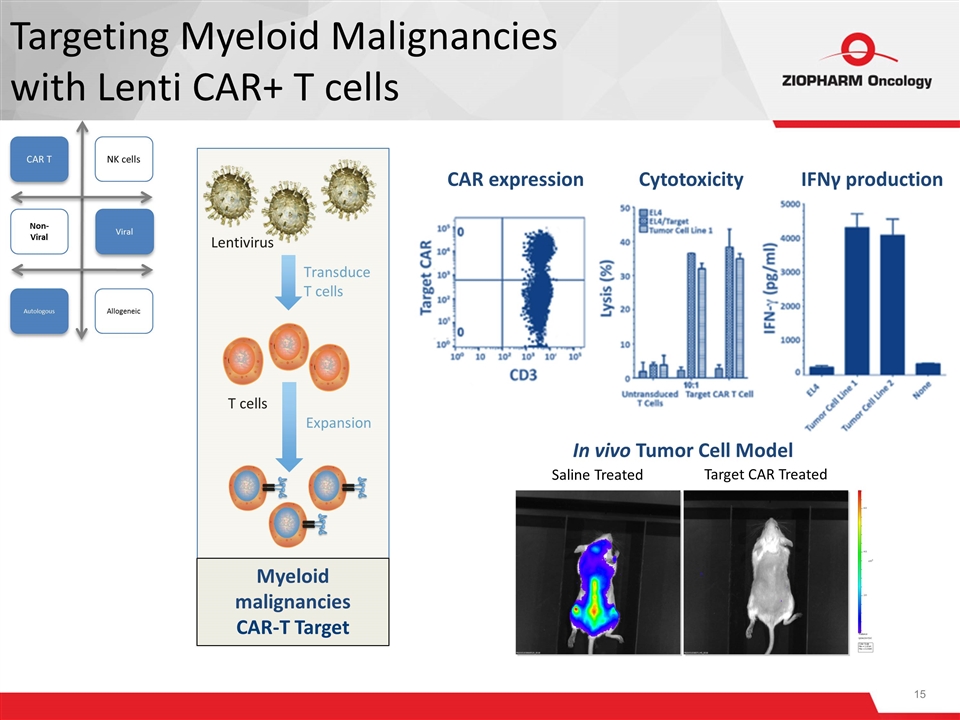
Target CAR T cells T cells Expansion Transduce T cells Lentivirus Targeting Myeloid Malignancies with Lenti CAR+ T cells CAR T NK cells Non-Viral Viral Autologous Allogeneic Cytotoxicity IFNγ production CAR expression Saline Treated Target CAR Treated In vivo Tumor Cell Model Myeloid malignancies CAR-T Target
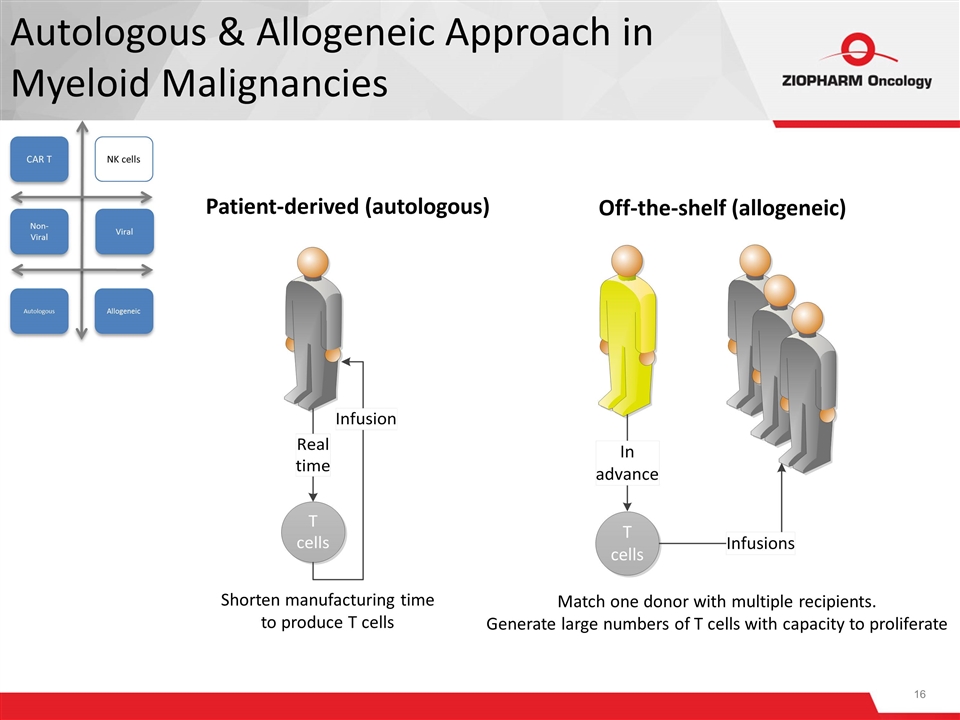
Autologous & Allogeneic Approach in Myeloid Malignancies Patient-derived (autologous) Off-the-shelf (allogeneic) CAR T NK cells Non-Viral Viral Autologous Allogeneic Shorten manufacturing time to produce T cells Match one donor with multiple recipients. Generate large numbers of T cells with capacity to proliferate
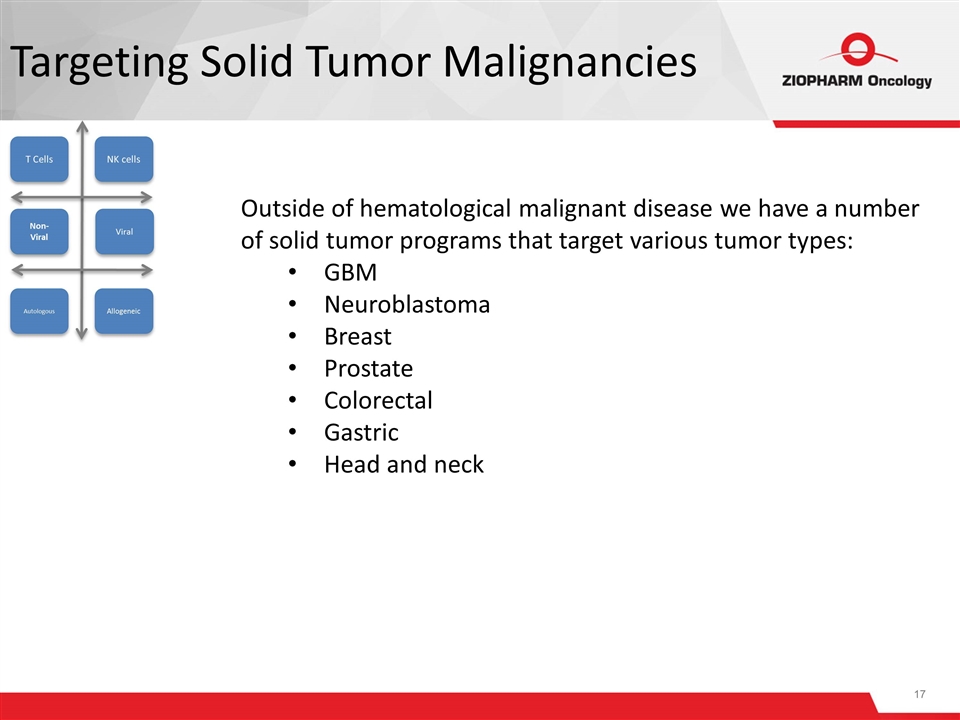
Targeting Solid Tumor Malignancies Outside of hematological malignant disease we have a number of solid tumor programs that target various tumor types: GBM Neuroblastoma Breast Prostate Colorectal Gastric Head and neck T Cells NK cells Non-Viral Viral Autologous Allogeneic
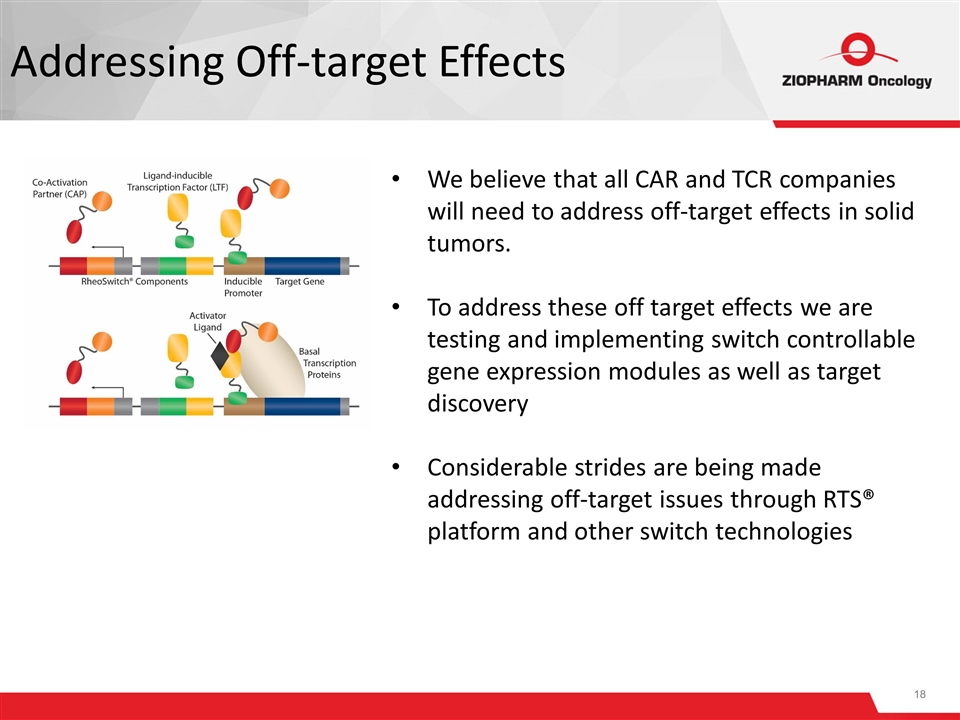
Addressing Off-target Effects We believe that all CAR and TCR companies will need to address off-target effects in solid tumors. To address these off target effects we are testing and implementing switch controllable gene expression modules as well as target discovery Considerable strides are being made addressing off-target issues through RTS® platform and other switch technologies
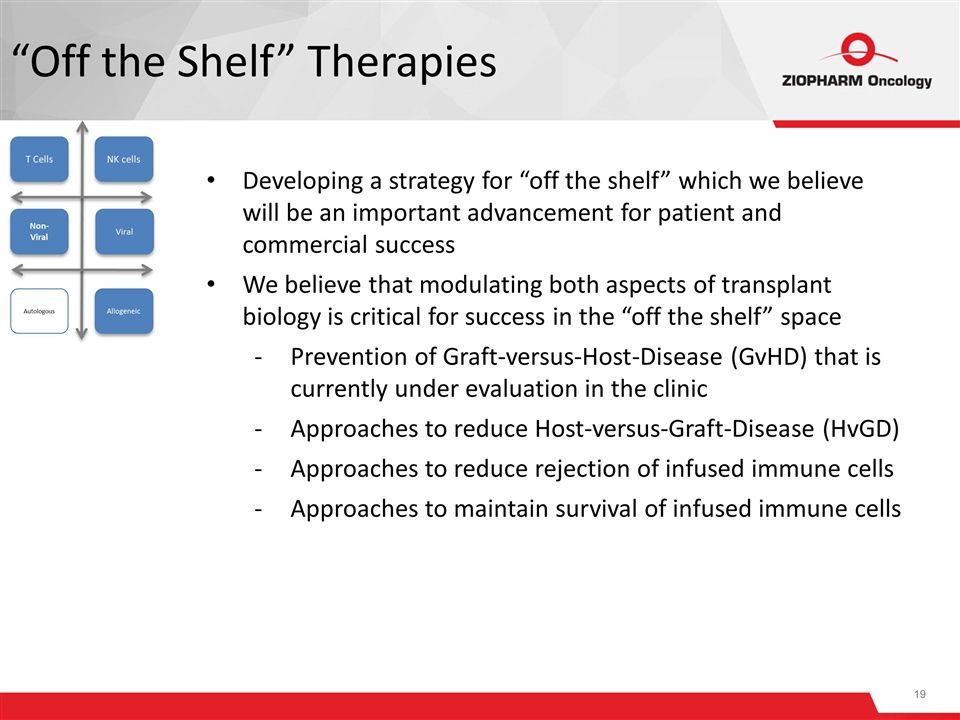
“Off the Shelf” Therapies Developing a strategy for “off the shelf” which we believe will be an important advancement for patient and commercial success We believe that modulating both aspects of transplant biology is critical for success in the “off the shelf” space Prevention of Graft-versus-Host-Disease (GvHD) that is currently under evaluation in the clinic Approaches to reduce Host-versus-Graft-Disease (HvGD) Approaches to reduce rejection of infused immune cells Approaches to maintain survival of infused immune cells T Cells NK cells Non-Viral Viral Autologous Allogeneic
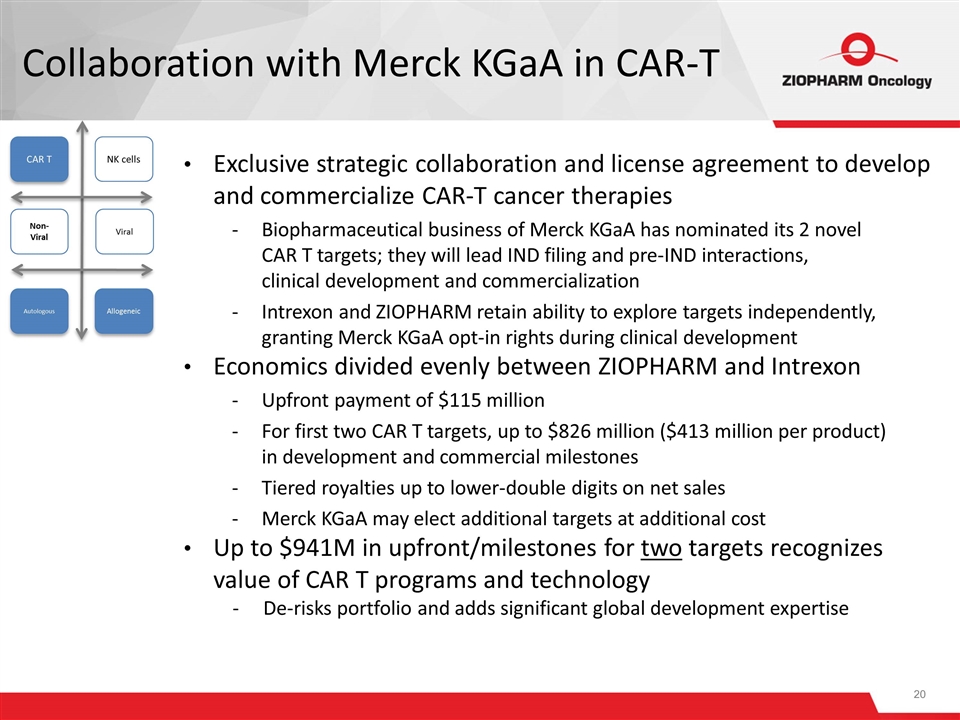
Exclusive strategic collaboration and license agreement to develop and commercialize CAR-T cancer therapies Biopharmaceutical business of Merck KGaA has nominated its 2 novel CAR T targets; they will lead IND filing and pre-IND interactions, clinical development and commercialization Intrexon and ZIOPHARM retain ability to explore targets independently, granting Merck KGaA opt-in rights during clinical development Economics divided evenly between ZIOPHARM and Intrexon Upfront payment of $115 million For first two CAR T targets, up to $826 million ($413 million per product) in development and commercial milestones Tiered royalties up to lower-double digits on net sales Merck KGaA may elect additional targets at additional cost Up to $941M in upfront/milestones for two targets recognizes value of CAR T programs and technology - De-risks portfolio and adds significant global development expertise CAR T NK cells Non-Viral Viral Autologous Allogeneic Collaboration with Merck KGaA in CAR-T

Collaboration with MDACC Fully leveraging our clinical collaboration with MDACC to rapidly evaluate various strategies Development is not limited to competitive CARs or TCRs Exploring cutting edge immunology to harness the full capability of gene modified adoptive cell types, such as various immune-modulatory strategies driving T or NK cell anti-tumor activity: PD-1 and CTLA-4 knock down Chimeric co-stimulatory receptors Transcription factors Cytokines (IL-2, IL-7, IL-15, IL-21 and IL-12) Chemokines T Cells NK cells Non-Viral Viral Autologous Allogeneic

MDACC ZIOPHARM’s Partnerships DNA engine Switches CARs TCRs Cytokines CAR T cells TCR and IL-12 Rapid Clinical Development Intrexon ZIOPHARM Merck KGaA NCI

Preclinical Phase I Phase II Pipeline Ad-RTS-IL-12 NK Cells Primary NK cells Combination with Ad-RTS-IL-12 Genetically-engineered TCR Sleeping Beauty TCR Sleeping Beauty TCR and cytokine Other Regulatory T Cells Modified Bacteria GBM Breast Cancer DIPG GBM + Checkpoint leukemia/lymphoma Undisclosed Undisclosed Undisclosed Undisclosed AML Brain Cancer TBD TBD TBD GvHD GvHD CAR CD19 1st Generation CD19 2nd Generation CD19 3rd Generation with cytokine Myeloid malignancies Target Merck Target 1 Merck Target 2 Off-the-shelf Myeloid malignancies Target

Summary R&D efforts provide us a competitive position in tumors outside of CD19 and an opportunity to take a leadership position as we leverage our immunological and technical expertise We are implementing a series of programming languages (operating systems) to control the immune system in humans RheoSwitch® platform Non-viral gene transfer This is being tested in multiple opportunities Virus CAR T, TCR, and NK Cells ZIOPHARM and Intrexon have the genetic programming tools and multitude of cell products needed in combination to treat cancer
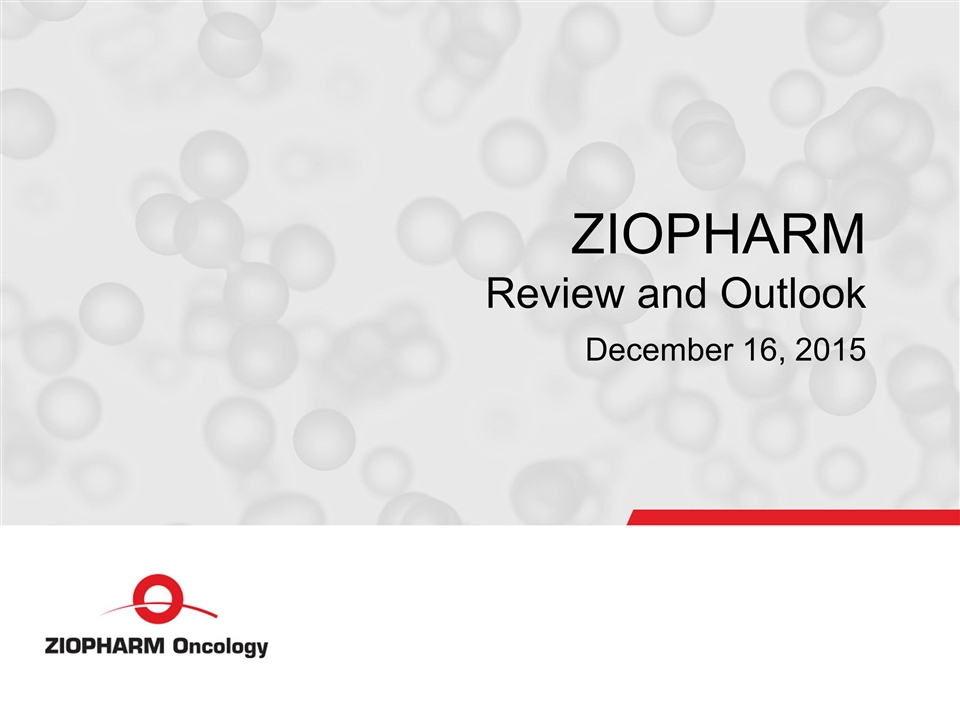
ZIOPHARM Review and Outlook December 16, 2015
